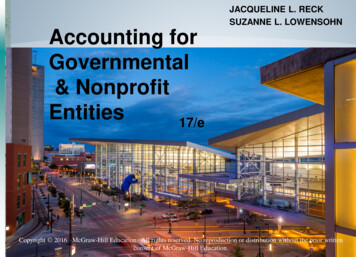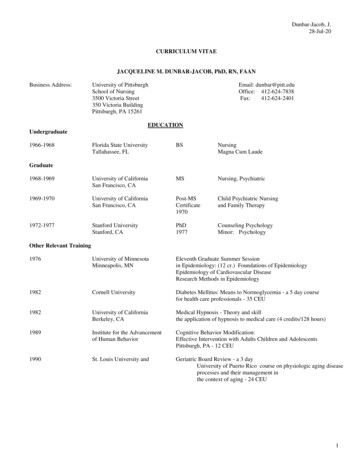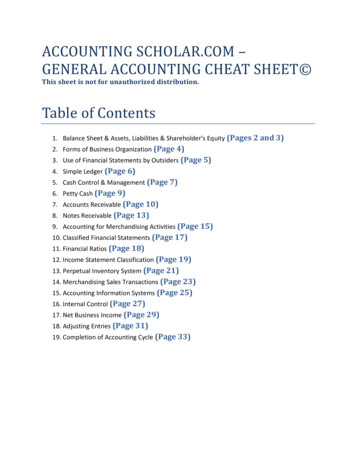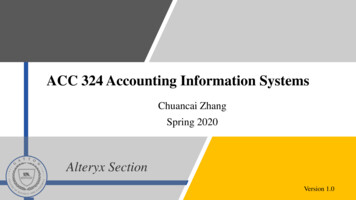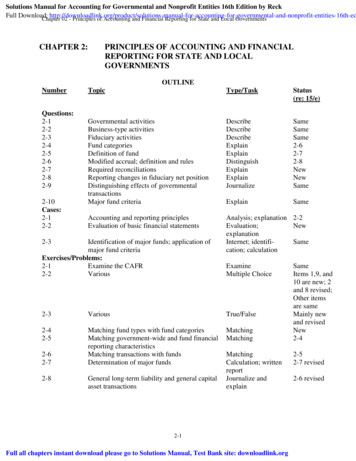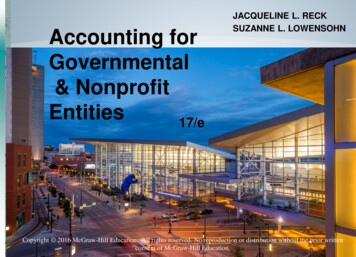
Transcription
Accounting forGovernmental& NonprofitEntities17/eJACQUELINE L. RECKSUZANNE L. LOWENSOHNCopyright 2016 McGraw-Hill Education. All rights reserved. No reproduction or distribution without the prior writtenconsent of McGraw-Hill Education.13-1
Accounting for Notfor-ProfitOrganizationsCHAPTER1313-2
Learning Objectives13-1 Distinguish not-for-profit organizations (NFPs)from entities in the governmental andcommercial sectors of the U.S. economy.13-2 Identify the authoritative standards-settingbody for establishing GAAP fornongovernmental NFPs.13-3
Learning Objectives13-3 Explain financial reporting and accounting forNFPs, including required financial statements;classification of net assets; accounting forrevenue, gains, and support; accounting forexpenses; and accounting for assets.13-4 Prepare financial statements in accordancewith the generally accepted accountingprinciples governing NFP organizations.13-4
Defining the Not-for-Profit Sector A not-for-profit organization is one whose goalsinvolve something other than earning a profit forowners, usually the provision of services. Rather than measuring success with profits,success is measured by how much theorganization contributes to the public wellbeingwith the resources available to it.13-5
Not-for-Profit Organizational FormsNot-for-profit (absenceof ownership interests)NongovernmentalTaxable (e.g. notmeeting taxexemptrequirements)Tax-exempt (e.g.social , healthcare, scientific,literary andserviceorganizations)GovernmentalGeneral purpose(e.g. states andcities)Special purpose(e.g. collegesand hospitals)13-6
Not-for-Profit CategoriesVoluntary health andwelfare organizationsOther nonprofitorganizationsColleges and universitiesHealth care entities13-7
Governmental or not? The not-for-profit audit and accounting guide of theAICPA, with the tacit approval of both the FASBand the GASB, has provided guidance on how todifferentiate a governmental organization from anot-for-profit organization. Colleges and universities, hospitals, museums, andsocial service agencies are examples oforganizations that may be either governmental ornongovernmental.13-8
GAAP for Nongovernmental NFPOrganizations The Financial Accounting Standards Board (FASB)has had responsibility for providing guidance ongenerally accepted accounting principles for notfor-profit organizations since 1979. The Governmental Accounting Standards Board(GASB) is responsible for governmentalorganizations including governmental not-for-profitorganizations.13-9
Objectives of Financial Reporting forNFPsFASB’s objectives of financial reporting for not-for-profitorganizations are to provide information useful inMaking resourceallocation decisionsAssessing servicesand ability to provideservicesAssessingmanagementstewardship andperformanceAssessing economicresources,obligations, netresources, andchanges in them13-10
Stakeholders of NFP onsumersMembersLenders13-11
Financial Reporting GAAP for not-for-profit organizations includes:– Accrual basis accounting– A statement of financial position– A statement of activities– A statement of cash flows– Comparative statements are encouraged but notrequired13-12
Statement of Financial Position Also known as a balance sheet, this statementshows assets, liabilities, and net assets for theorganization as a whole. Net assets are required to be reported in threecategories:– Unrestricted net assets– Temporarily restricted net assets– Permanently restricted net assets13-13
Statement of Financial PositionFASB standards require (at a minimum) that thestatement of financial position provide amounts fortotal assets, total liabilities, total net assets, and thetotals for each of the net asset classifications.13-14
Statement of Activities The statement of activities is an operatingstatement that presents, in aggregated fashion, allchanges in unrestricted net assets, temporarilyrestricted net assets, permanently restricted netassets, and total net assets for the reportingperiod. In the common four-column format for presentingthe changes in net assets, a column is used toshow changes occurring in each net asset classduring the reporting period.13-15
Reclassification“Net Assets Released from Restrictions” indicatesthe reclassification of temporarily restricted supportto unrestricted support in the year in which the donorstipulations were met.Reclassifications may be due to (1) satisfaction ofprogram or purpose restrictions, (2) satisfaction ofequipment acquisition restrictions, sometimesmeasured by depreciation expense, and (3)satisfaction of time restrictions, either actual donor orimplied restrictions.13-16
Statement of Cash Flows The classifications used on the statement of cashflows are the same as those used by investorowned entities: operating, investing, and financing. Either the direct or indirect method may be used toreport operating cash flows, but a reconciliation ofchange in total net assets to net cash used foroperating activities must be presented when thedirect method is used.13-17
Statement of Cash FlowsClassificationsActivity or transactionClassification on Statement ofCash FlowsReceipt of unrestricted giftOperating activitiesReceipt of and earnings on netassets permanently ortemporarily restricted for longterm purposesFinancing activitiesSale of donated financial assetwith no restrictionsOperating activitiesAcquisition of a building orequipment using temporarilyrestricted net assetsInvesting activitiesNoncash or in-kind contributionsNoncash investing and financingactivities13-18
Statement of Functional ExpensesProgram ActivitiesResearch PublicAwarenessTotalSupporting ServicesManagerial FundRaisingTotalThe column headers shown above are examplesof functional classifications.13-19
Statement of Functional ExpensesProgram ActivitiesResearch PublicAwarenessTotalSupporting ServicesManagerial FundRaisingTotalSalariesSuppliesRentThe row labels shown above are examples ofnatural classifications or objects of cost.13-20
Statement of Functional Expenses VHWO organizations are required to prepare astatement of functional expenses, but other NFPorganizations are also encouraged to do so. Expenses that relate to more than one functionshould be allocated to the programs or functionalexpenses benefited.13-21
Notes to the Financial Statements Disclosures in the notes include principlesapplicable to investor owned organizations. NFP organizations must disclose the nature andamounts of unrestricted, temporarily restricted, andpermanently restricted net assets if not displayedon the face of the financial statements. Certain policy statements should also be includedin the notes.13-22
Revenues, Gains and SupportRevenuesGainsSupport Increases in unrestricted net assets arising fromexchange transactions in which the other party to thetransaction is presumed to receive direct tangiblebenefit commensurate with the resources provided Increases in net assets that relate to peripheral orincidental transactions of the entity and often arebeyond the control of management A category of revenues arising from contributions ofresources or nonexchange transactions and includesonly amounts for which the donor derives no tangiblebenefits from the recipient agency13-23
Contributions and GiftsA contribution is avoluntaryunconditionalnonreciprocaltransfer of assets or cash to a NFP (or settlement orcancellation of liabilities)by an entity external to the NFP13-24
Donor ContributionsUnrestrictedRestrictedas to timeRestrictedas topurpose13-25
Pledges A pledge is a promise to give assets to an organization. A conditional promise to give depends on the occurrence of aspecified future and uncertain event to bind the promissor,such as obtaining matching gifts by the recipient.– A conditional promise to give is not recorded until the conditionsupon which it depends have been substantially met. An unconditional promise to give depends only on thepassage of time or demand by the promisee for performance– These promises are reported as support in the year the promiseis made, although they are considered temporarily restricted untilit is clear the donor intent related to the contribution has beenmet.13-26
Gifts in KindA gift in kind is a donation of materials orservices.Unconditional gifts in kind should be reported atfair value, and the entry would include bothcontribution revenue and an expense ornoncash asset.Donated materials used or consumed in providingservices should be reported as part of the cost ofthe services.13-27
Contributed Services FASB requires recognition of contributed servicesat their fair value if the services received(1) create or enhance nonfinancial assets OR(2) require specialized skills, are provided byindividuals possessing those skills, and typicallywould need to be purchased if not provided bydonation. A donation of advertising time is considered to bea contributed asset rather than a contributedservice and therefore does not have to meet thesecond criteria.13-28
Land, Buildings and Equipment Land, buildings and equipment are recorded at fairvalue at the time of donation, and may beunrestricted, temporarily restricted or permanentlyrestricted. For buildings and equipment classified astemporarily restricted, an amount equal to annualdepreciation expense is typically reclassified fromtemporarily restricted to unrestricted net assetseach year.13-29
Special EventsReceiptsfrom theeventFASB requires that revenues fromspecial events be reported at grossDirectexpenseDirect expenses of providing thebenefit reported separately.Fund-raisingexpenseExpenses related to promoting andconducting special events arereported as fund-raising expenses.13-30
Contributions with Intermediaries An intermediary serves in a fiduciary capacity byhelping with the transfer of assets between a donor anda beneficiary. Generally, an intermediary records an asset and aliability when it receives a donation on behalf of anotherorganization. However, if the agent or intermediary has variancepower or is interrelated to the beneficiary organization,contribution revenue is recognized. Variance power exists when the agent or intermediaryhas the ability to redirect the assets it receives to anentity other than the beneficiary organization.13-31
Financially Interrelated13-32
Accounting for ExpensesExpensesAccrual basisaccountingRecorded asdecreases inFunctionalunrestricted classificationsnet assets13-33
Functional Expenses Program classifications result from the provision ofgoods or services that help achieve the majorpurposes or mission:– Research– Information– Advocacy and public awareness Support activities assist the NFP in carrying out itsmission:– Fund-raising– Management and general13-34
Joint Costs of Fund-raising Not-for-profit organizations often conduct activitiesthat combine a program or administrative activitywith fund-raising. FASB guidelines for allocating joint costs of theseactivities are as follows:13-35
Joint Costs of Fund-raisingFASB guidelines : The total cost of activities that include a fund-raising appealshould be reported as fund-raising costs unless a bona fideprogram or management and general function has beenconducted in conjunction with the appeal for funds. The joint costs of a bona fide program or management andgeneral function should be allocated between the bona-fidefunction and fund-raising using an equitable allocation base. Criteria of purpose, audience, and content must be met inorder to conclude that a bona fide program or managementand general function has been conducted in conjunction withthe appeal for funds.13-36
CriteriaPurposeAudienceContent13-37
Criteria Met IfPurpose The joint activity helps accomplish a programpurpose or a management activityAudience The audience was selected primarily for aprogram or management purpose rather thanability to make a donationContent The joint activity motivates the audience toaction in furtherance of the mission, or meets amanagement responsibility13-38
Management and General ingLegal ServicesOfficemanagement13-39
Restricted Assets Assets that are not available for current operatingpurposes because donors have limited their use toa long-term purpose (e.g., capital asset acquisition)are considered restricted. FASB indicates that such assets should beclassified separately from current assets on theface of the statement of financial position.13-40
InvestmentsItem or issueTreatmentPurchase investmentsAcquisition priceDonated investmentsFair market value on date of donationReporting periods, such asfiscal year endFair market value at measurement dateCategory classificationNot requiredRealized and unrealizedgain or lossReported on current period’s statement ofactivitiesAffects appropriate net asset account(unrestricted, temporarily restricted orpermanently restricted)FootnotesDetailed disclosures13-41
CollectionsCollections are defined as works of art, historicaltreasures, or similar assets that are1. Held for public exhibition, education, or research infurtherance of public service rather than financial gain.2. Protected, kept unencumbered, cared for, and preserved.3. Subject to an organizational policy that requires theproceeds of items that are sold to be used to acquire otheritems for collection.Collections may be recognized or not recognized asassets, but selective capitalization is not permitted.13-42
CollectionsCapitalized collections should be recognized as assets inthe period in which they are acquired.Capitalized art or historical treasures need not bedepreciated so long as their economic benefit is used upso slowly that their estimated useful lives areextraordinarily long. This characterist
Other nonprofit organizations . Colleges and universities . Health care entities . 13-8 Governmental or not? The not-for-profit audit and accounting guide of the AICPA, with the tacit approval of both the FASB and the GASB, has provided guidance on how to differentiate a governmental organization from a not-for-profit organization. Colleges and universities, hospitals, museums, and .
